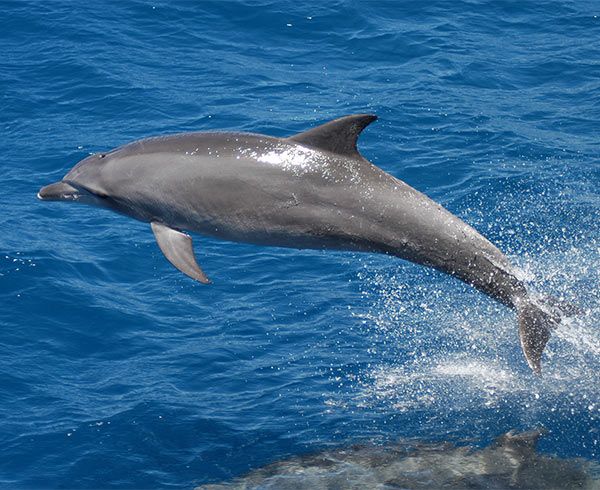Whale & Dolphin Watching
Minke Whales
Silversonic has one of the few permits, issued by the Great Barrier Reef Marine Park Authority, to swim with the inquisitive minke whale if encountered – it’s a truly unforgettable and unique in-water experience!
As with nature, whale encounters are never guaranteed but from our experience, July to September is the peak season to encounter the inquisitive minkes as they frequent the Agincourt ribbon reefs where Silversonic visits. They are however common in our waters between the months of March and October.
The dwarf minke (Balaenoptera acutorostrata subspecies) is the smallest baleen whale, identified by about 50-70 throat grooves. They have a characteristic white band on each flipper, contrasting with its very dark grey top colour. They have two blowholes, like all baleen whales.
Abiding by strict codes of practice, a maximum of two surface ropes will be placed in the water with swimmers then positioned 3-4 metres apart for a magical, and safe encounter. The whales actually control the encounter in that they decide how close they interact and swim with us!
The dwarf minke whale occurs only in the southern hemisphere, and the Great Barrier Reef provides habitat for their only known reliable aggregation in the world. They grow to a maximum of around 8m, with adults weighing around 5-6 tonnes.

HUMPBACK WHALES
It’s always exciting to see the gentle giants of the sea, the Humpback Whales arrive in our warmer tropical waters and a great bonus for our passengers and crew.
Generally, the onset of autumn sees the humpbacks begin their long trek up the east coast of Australia to the Great Barrier Reef. While not guaranteed, regularly sightings at the reef occur during the months of July to September.
They are easily identified by their extremely long pectoral fins and scalloped flukes. Humpbacks are referred to as Baleen whales, as they filter sea water through large fibrous plates in their mouths to feed on the krill. They rarely travel any further north than Cape Tribulation, so we are at the end of their long migration and they tend to gather here in large numbers.
The reason they travel north is to get to warmer waters to breed and calve. Warm tropical waters have little food for the whales to feast upon, so the whales rely on their fat reserves they have accrued by feeding on krill in Antarctic waters. As they travel up the coast, the whales begin to form small groups or mating pairs.

DOLPHINS
The most common species of Dolphin encountered at the Reef is the spinner dolphin, named because of the aerial behaviours they perform when leaping out of the water. These small dolphins will often ride the pressure wave off the bow of slow moving vessels.
Dolphins belong to the cetacean group, which includes their larger relatives, the whales. Dolphins are basically toothed whales, and as such, are grouped with pilot and sperm whales, as opposed to the baleen group (Humpbacks), which have straining plates to sieve plankton.
Dolphins evolved from mammals, and have perfected a streamline body extremely efficient for movement through the water. Their tails are horizontal (as opposed to vertical in fishes), and lack any bone support, and through a series of tendons are able to produce powerful strokes to move through the ocean. Dolphins can dive deep, but need to surface every few minutes to breathe.
Dolphins form large groups called pods, and there is a strict social hierarchy within the group. Some female dolphins will assist in midwife duties, and mourn with families when a member dies. Adults will attempt to deter predators such as sharks away from the pods, and diligently defend their babies.

Privacy Policy | Terms & Conditions | Part of the Quicksilver Group
Copyright © 2024 SilverSeries


